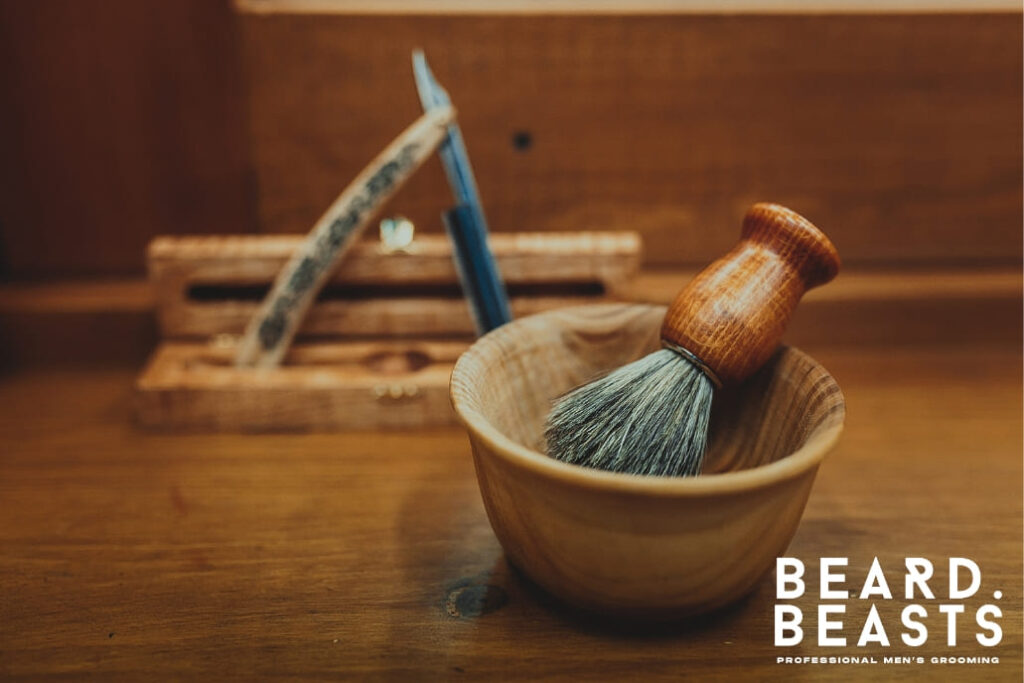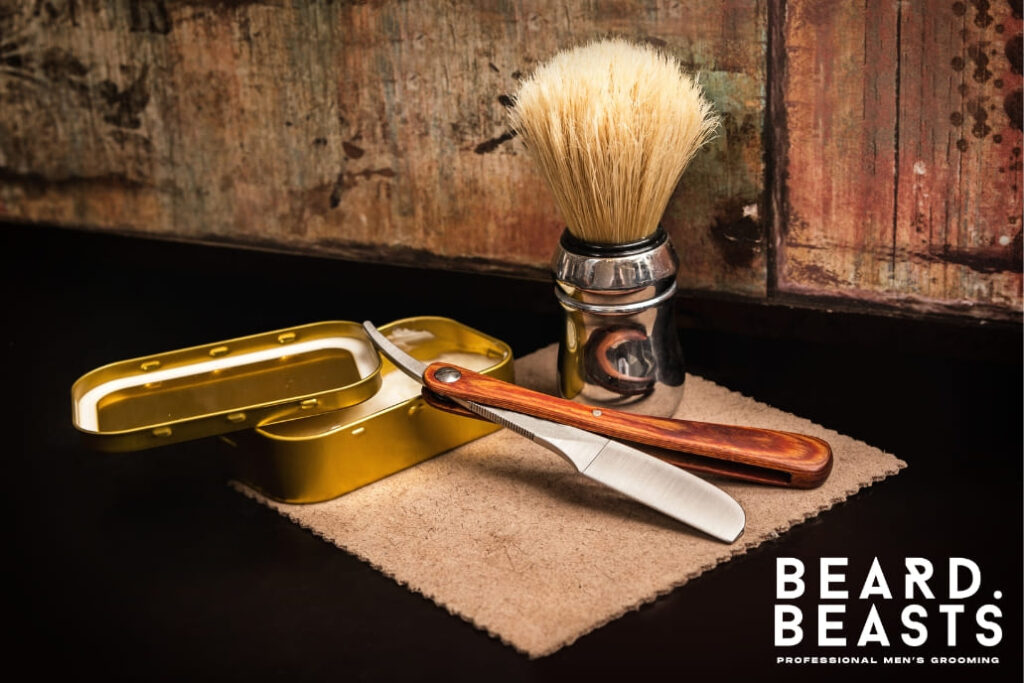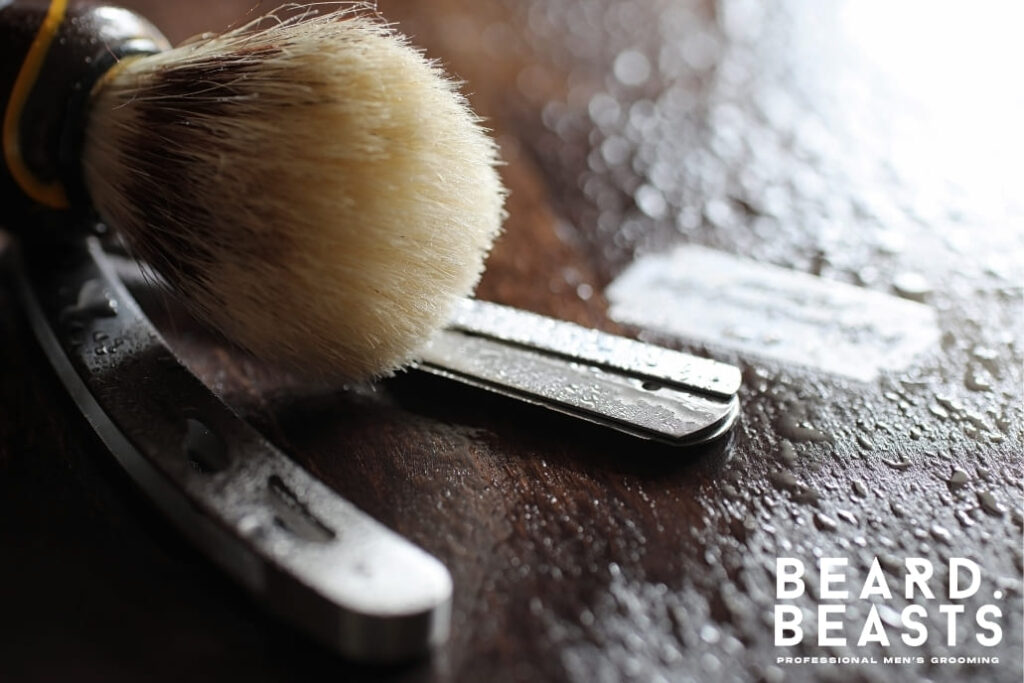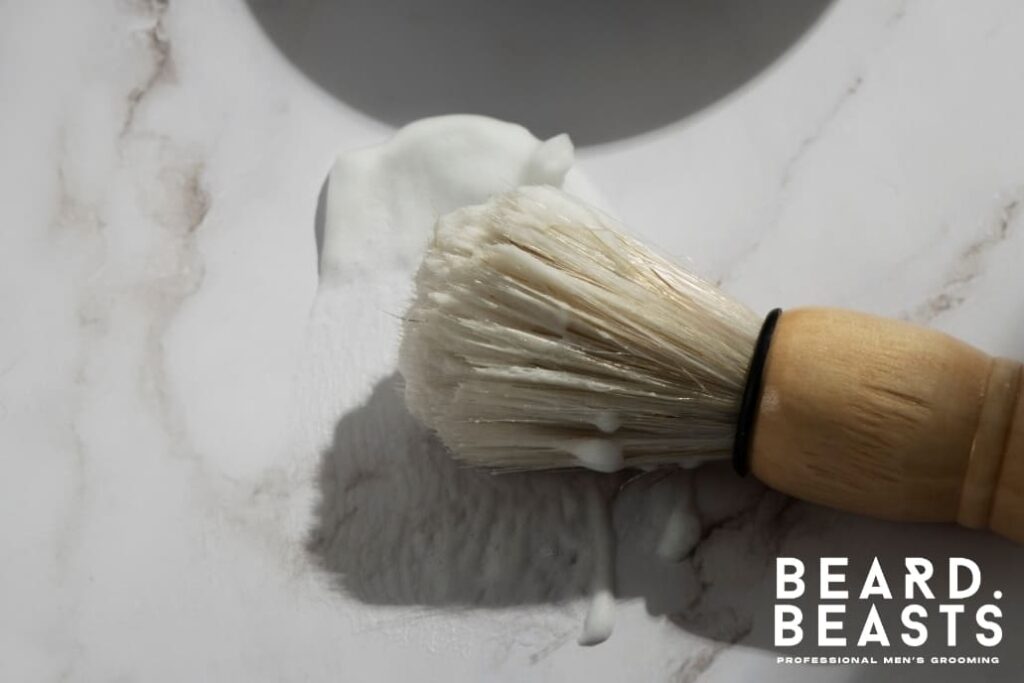The secret to a truly luxurious wet shave lies in your shaving brush. But to unlock its full potential, you need to know how to clean a shaving brush. It’s more than just hygiene; a clean brush performs better, lasts longer, and protects your skin.
Whether you’re a wet-shaving veteran or a novice, this guide will teach you everything from daily rinses to deep-cleaning techniques, ensuring your brush stays in top condition and your shaves remain a pleasure. Let’s get started on the path to a pristine brush and elevate your daily shave.
Why Cleaning Your Shaving Brush Is Essential
For a truly superior shave, a clean brush isn’t a luxury; it’s a necessity. It’s about more than just hygiene; it impacts the performance of your brush, the longevity of your investment, and the health of your skin. Understanding how to clean a shaving brush is crucial for anyone serious about their grooming routine.

The Key Benefits of a Clean Brush
- Hygiene and Your Skin: Your shaving brush is in direct contact with your skin. A dirty brush harbors bacteria and mold, leading to potential irritation, razor bumps, and even infections. Regular cleaning is paramount for a hygienic shave and healthy skin.
- Protecting Your Investment: A quality shaving brush can last for years with proper care. Cleaning removes residue that weakens bristles and damages the knot, ensuring your brush remains a reliable tool for the long haul.
- Performance and Lather: A clean brush creates a far richer, more luxurious lather than a dirty one. This translates to a smoother, closer, and more enjoyable shave.
The Downsides of Neglect: What to Expect
- Clogged and Stiff Bristles: Shaving soap, cream, and oil residue accumulates, causing bristles to clump together. This makes the brush less effective and increasingly difficult to clean.
- Foul Odors: A damp, unclean brush is a breeding ground for bacteria, resulting in unpleasant, musty odors – a clear sign your brush needs attention.
- Skin Irritation and Breakouts: Transferring bacteria from a dirty brush to your skin is a recipe for problems. Expect irritation, redness, and potential breakouts if you neglect cleaning.
In essence, a clean shaving brush is fundamental to a healthy and enjoyable shaving experience. It’s an investment in your skin, your tools, and your overall grooming ritual.
How to Clean a Shaving Brush: A Step-by-Step Guide
It’s clear by now, mastering how to clean a shaving brush is essential for maintaining its performance and hygiene. This comprehensive, step-by-step guide will walk you through the process, ensuring your brush stays in pristine condition.

Step 1: The Initial Rinse – Loosening Debris
Begin by thoroughly rinsing your shaving brush under warm running water. Hold the brush with the bristles pointing downwards and gently spread them with your fingers. This allows the water to penetrate deep into the knot, the densest part of the brush where the bristles are gathered, effectively loosening any trapped shaving cream, soap, or debris from your previous shave.
Pro Tip: Avoid hot water!
Step 2: Preparing Your Cleaning Solution
In a small bowl, create a gentle cleaning solution. You can use a mild soap, such as baby shampoo, or a specialized shaving brush cleaner, which is specifically formulated to clean and condition brush bristles. Add warm water to the soap and mix until you have a slightly soapy solution, but avoid making it overly concentrated.
Note: Harsh chemicals and strong detergents can strip the natural oils from badger hair and other natural bristles, making them brittle and prone to breakage.
Step 3: Lather and Clean – Working the Brush
Dip your brush into the cleaning solution and begin to work it into a lather, just like you would when preparing for a shave. You can swirl the brush in your palm or in the bowl, using gentle circular motions. This action helps to lift out deep-seated residue, oils, and any remaining debris from the knot and throughout the bristles, ensuring a thorough clean.
Tip: Swirling the brush in your palm allows for greater control and ensures the cleaning solution penetrates all the bristles.
Step 4: The Final Rinse – Removing All Residue
Thoroughly rinse your brush under warm running water. Gently spread the bristles to ensure all traces of soap and residue are completely washed away. Proper rinsing is crucial to prevent buildup that can affect the brush’s performance, making it feel stiff and less effective at creating a lather. Continue rinsing until the water runs clear.
Step 5: Squeeze and Towel Dry
Once the water is running clear, gently squeeze the excess water from the bristles. Start at the base, where the bristles meet the handle, and work your way up. Be careful not to pull or twist the bristles, as this can cause them to break or become misshapen. After squeezing, gently pat the brush with a clean, dry towel to remove any remaining moisture. This helps to speed up the drying process.
Step 6: Proper Drying – The Key to Longevity
Always hang your shaving brush bristle-side down in a well-ventilated area to dry. This allows gravity to pull any remaining water away from the knot, preventing potential damage to the adhesive that holds the bristles in place. A dedicated shaving brush stand is ideal for this purpose, as it promotes proper airflow and keeps the brush in the optimal drying position.
Reminder: Never store a damp brush in an enclosed space, such as a drawer or cabinet.
By mastering how to clean a shaving brush using these steps, you’re not just cleaning a tool; you’re investing in its longevity and ensuring a consistently superior shave. With proper care, your shaving brush will remain a prized part of your grooming ritual for years to come.
Deep Cleaning Your Shaving Brush: Essential Tips
While regular cleaning is essential, periodic deep cleaning is crucial for your shaving brush’s long-term health, performance, and hygiene. Deep cleaning removes stubborn buildup that regular rinsing can’t touch, keeping your brush fresh and effective. Here’s how to clean a shaving brush thoroughly with a deep clean.

When and Why to Deep Clean:
- Routine Maintenance: For most users, a deep clean every 4-6 weeks is ideal to prevent the gradual accumulation of soap scum and hard water minerals.
- Increased Usage or Heavier Products: If you use your brush frequently or with thicker creams, deep clean every 2-3 weeks.
- Noticeable Odor or Stiffness: If your brush develops a persistent musty odor or the bristles feel stiff even after rinsing, it’s time for a deep clean.
- Visible Residue: If you can see a buildup of residue, especially deep within the knot, it is time for a deep clean.
Why It Matters: Deep cleaning prevents long-term damage to the bristles, protects the brush knot, and ensures a consistently smooth, irritation-free shave.
Methods: Vinegar or Borax
Option 1: The Vinegar Method
- Prepare the Solution: Mix one part white vinegar to two parts warm water in a small bowl.
- Soak and Swirl: Dip the bristles into the solution, ensuring they are fully submerged. Gently swirl for 2-3 minutes.
- Rinse Thoroughly: Rinse under warm running water until the vinegar odor is completely gone.
Option 2: The Borax Method
- Dissolve the Borax: Dissolve one teaspoon of borax powder in a cup of warm water, stirring until completely dissolved.
- Submerge and Swirl: Submerge the bristles in the solution and gently swirl for 2-3 minutes.
- Rinse Completely: Rinse thoroughly under warm running water, ensuring all traces of borax are removed.
Pro Tip: Both vinegar and borax are highly effective at removing deep-seated soap scum and hard water deposits.
Caution: Test on the handle first to ensure it does not cause discoloration.
Mistakes to Avoid:
- Hot Water: Always use warm water to avoid damaging the adhesive that holds the knot together.
- Harsh Chemicals: Avoid bleach or strong detergents, which can strip natural oils and damage bristles.
- Oversoaking: Limit soaking time to 3-5 minutes to prevent potential damage to bristles and the knot.
- Improper Rinsing: Make sure to rinse your brush thoroughly after either method to prevent buildup.
Regular deep cleaning is essential for maintaining your shaving brush. By following these tips, you’ll ensure your brush remains effective, hygienic, and a pleasure to use for years to come. Mastering how to clean a shaving brush thoroughly enhances your entire shaving experience.
How Often Should You Clean Your Shaving Brush?
Knowing how to clean a shaving brush is essential, but understanding the optimal cleaning frequency is equally crucial. The right balance between daily care and periodic deep cleaning ensures your brush remains in peak condition, performs flawlessly, and lasts for years.

Daily Care: The Foundation of Brush Maintenance
Rinsing your shaving brush after each use is non-negotiable. This simple act prevents the buildup of shaving cream or soap residue, keeps the bristles soft, and maintains basic hygiene.
Steps for Daily Rinsing:
- Rinse Thoroughly: Hold the brush under warm running water, bristles facing down.
- Spread Bristles: Gently spread the bristles to ensure water penetrates the knot, the core of the brush.
- Squeeze and Pat: Gently squeeze out excess water, then pat the brush with a clean towel.
- Hang to Dry: Hang the brush bristle-side down to allow for complete drying.
Why It Matters: Daily rinsing prevents residue buildup, inhibits bacterial growth, and keeps your brush ready for its next use.
Deep Cleaning: The Long-Term Strategy
While daily rinsing is vital, it doesn’t eliminate all accumulated residue. Deep cleaning, performed every few weeks, is necessary for removing stubborn oils, soap scum, and hard water deposits that can compromise the brush’s performance and longevity.
Deep Cleaning Frequency:
- Regular Users (Daily or Near-Daily Shaving): Deep clean every 2-3 weeks, especially if using denser creams.
- Occasional Users (2-3 Times Per Week): Deep clean every 4-6 weeks.
Why It Matters: Deep cleaning prevents long-term buildup, protects the bristles and knot, and ensures a consistently superior shave.
By mastering not only how to clean a shaving brush but also when to clean it, you’re ensuring a luxurious and hygienic shave every time. Proper maintenance is an investment in your brush and your overall grooming experience.
How to Store Your Shaving Brush After Cleaning: Key Tips
Proper storage is equally as important as knowing how to clean a shaving brush for its longevity and performance. Correct drying and storage techniques prevent mildew, mold, and bristle damage.
The Importance of Drying:
A damp shaving brush is a breeding ground for bacteria and mold, especially in humid environments. After rinsing, gently squeeze out excess water, pat with a clean towel, and allow the brush to air dry completely before storing.
Storage: Hanging vs. Standing
Hanging – The Best Method:
Hanging your brush bristle-side down is ideal. This allows gravity to pull water away from the knot, preventing damage to the adhesive and promoting faster, more thorough drying.
Standing – An Alternative:
If you can’t hang your brush, standing it upright is acceptable. Ensure it’s thoroughly towel-dried beforehand and placed in a well-ventilated area to facilitate drying.
Mistakes to Avoid:
- Enclosed Spaces: Never store a damp brush in a closed cabinet or drawer, as this traps moisture and encourages mold growth.
- Direct Heat: Avoid placing your brush near direct heat sources like radiators or in direct sunlight, as this can make bristles brittle.
- Skipping Drying: Always ensure your brush is completely dry before long-term storage.
Key Takeaway: Proper storage is just as crucial as knowing how to clean a shaving brush. Whether you choose to hang or stand your brush, ensure it dries completely in a well-ventilated area. This guarantees a hygienic, effective, and long-lasting shaving tool.
Conclusion: Master How to Clean a Shaving Brush for an Elevated Shave
Mastering how to clean a shaving brush is a key part of any discerning grooming routine. From daily rinsing to periodic deep cleaning and proper storage, each step contributes to your brush’s hygiene, performance, and longevity. By embracing these practices, you’re not just maintaining a tool; you’re elevating your entire shaving experience.
A well-maintained brush delivers:
- Superior Hygiene: Minimizing the risk of bacteria and mold, ensuring a healthier shave.
- Peak Performance: Creating a consistently rich, luxurious lather for a smoother, more comfortable shave.
- Extended Lifespan: Protecting your investment and ensuring your brush serves you well for years to come.
A well-cared-for shaving brush is a testament to your commitment to quality grooming. Whether you’re a seasoned wet-shaving enthusiast or new to this timeless tradition, you now possess the knowledge to keep your brush in pristine condition. Use this definitive guide on how to clean a shaving brush, and enjoy the rewards of a truly exceptional shave.





